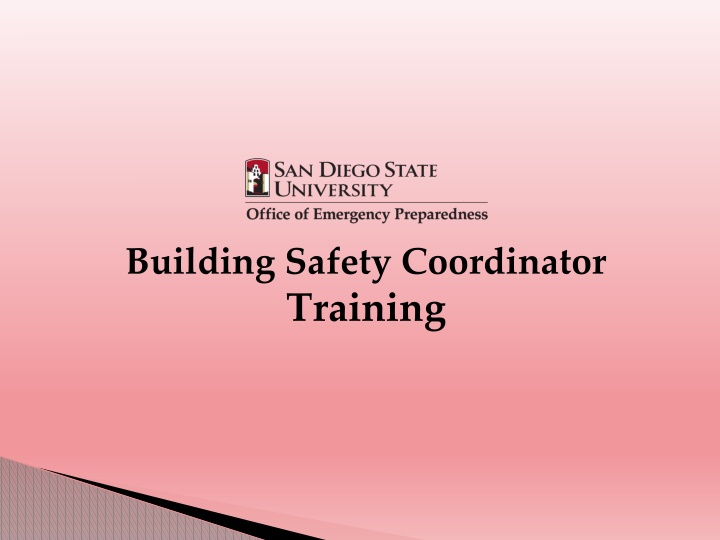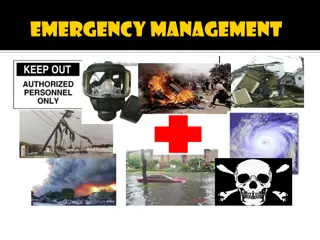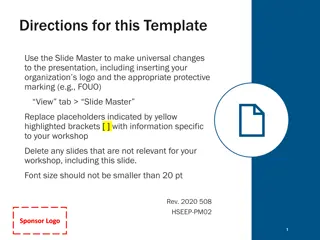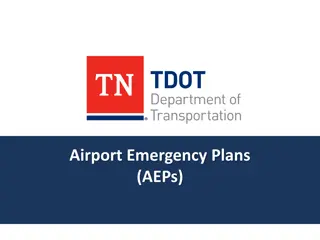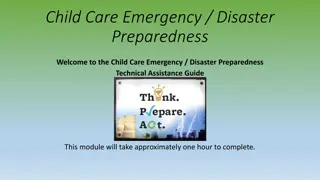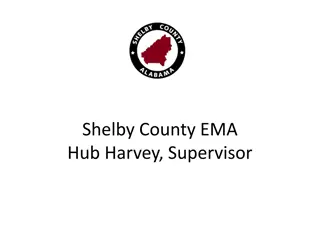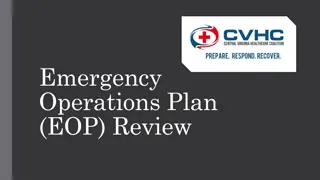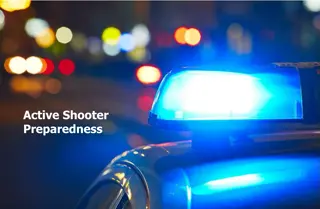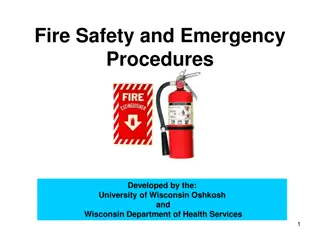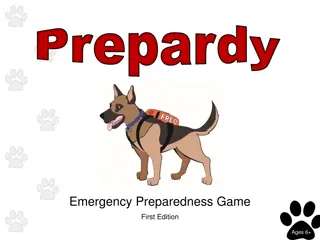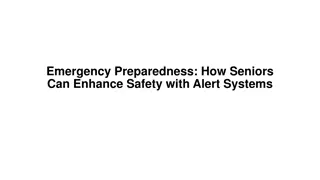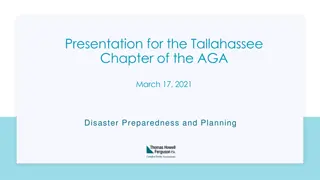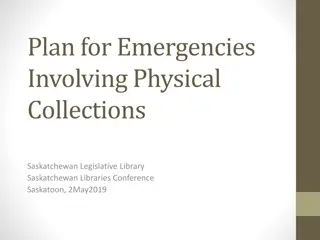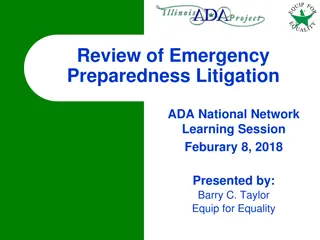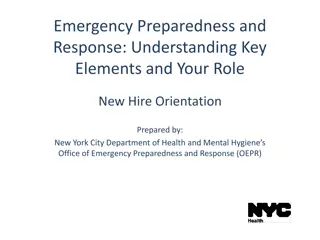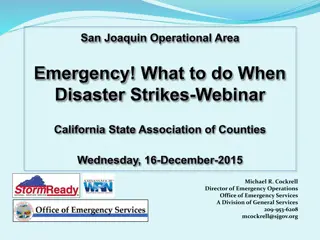Comprehensive Building Safety and Emergency Preparedness Training
Enhance your safety preparedness with Building Safety Coordinator Training, Emergency Preparedness resources, Communication Resources, Fire Safety procedures, and Earthquake Safety measures. Learn about fire extinguisher use, fire response procedures, earthquake safety considerations, and the seven steps to earthquake safety for a well-rounded safety approach. Be proactive in planning, discussing responses, and familiarizing yourself with campus procedures to ensure a safe environment for all.
Download Presentation

Please find below an Image/Link to download the presentation.
The content on the website is provided AS IS for your information and personal use only. It may not be sold, licensed, or shared on other websites without obtaining consent from the author.If you encounter any issues during the download, it is possible that the publisher has removed the file from their server.
You are allowed to download the files provided on this website for personal or commercial use, subject to the condition that they are used lawfully. All files are the property of their respective owners.
The content on the website is provided AS IS for your information and personal use only. It may not be sold, licensed, or shared on other websites without obtaining consent from the author.
E N D
Presentation Transcript
Building Safety Coordinator Training
Emergency Preparedness http://www.sdsu.edu/prepare Prepare for potential incidents that could occur Plan and discuss office response Be familiar with campus procedures Emergency Procedures Poster https://bfa.sdsu.edu/safety/emergency/emerprep/docs/emergency_services_flyer.pdf https://bfa.sdsu.edu/safety/emergency/emerprep/docs/2019_emergencyposter_ivc.pdf
Communication Resources SDSU Alert (text messaging): www.sdsu.edu/sdsualert SDSU Home page at www.sdsu.edu & www.sdsu.edu/urgent Emergency Operations Information Line at 1-866-794-8832 Facebook at http://www.facebook.com/SanDiegoState Twitter at http://twitter.com/@SDSU_NewsTeam/ Department resources: For example, phone tree, panic buttons
Fire Extinguisher Fire extinguishers are rated as A, B, C, or combination Types Class A - Wood and Paper Class B - Grease or Combustible Liquids Class C - Electrical Additional fire extinguisher training available Use a fire extinguisher to extinguisher small fires only if safe to do so and you have a safe exit path.
Fire Response Basic Procedures Fire Response (R.A.C.E.) Rescue Alarm Confine Extinguish Fire Extinguisher Use (P.A.S.S.) Pull the pin Aim at the base of the fire Squeeze the handle gently Sweep side to side
Earthquake Safety Special Considerations In outdoor areas Move to a clear area if safe to do so. Avoid power lines, trees, signs, buildings, vehicles and other hazards. In science labs and workshops Assist with extinguishing any open flames and isolating hazardous materials when safe. Individuals with disabilities - access and functional needs (D-AFN) Protect oneself as best possible right where you are, use arms to protect head and neck.
Earthquake Reminders Take a look now to see if items need to be secured. Remove or secure items in offices or classrooms that might fall. Check department and individual emergency supplies to make sure they are accessible and functional. A resource includes Ready America supplies: http://bit.ly/EDP-SDSU.
The Seven Steps to Earthquake Safety www.earthquakecountry.info/roots/seven_steps.html Prepare Step 1: Secure it now! Step 2: Make a plan Step 3: Prepare a disaster kit (Ready America) Step 4: Is your place safe Step 5: Learn DROP, COVER and HOLD ON Step 6: Check it out Step 7: Communicate and recover
Emergency Evacuation Personnel University Police Police Officers @ Command Post Police Officers or designees @ Assembly Points Office of Emergency Preparedness Environmental Health & Safety Building Safety Coordinators
Emergency Evacuation Procedures Activation of the fire alarm signals an evacuation. Everyone is required to evacuate the building immediately. Building Safety Coordinators have yellow vests and flags. Employees should know the location of: Telephones Building exits Fire safety equipment and devices Assembly points Employees should consider alternative evacuation routes and assembly points before an incident.
Emergency Evacuation Procedures If this is an active shooter scenario - Run. Hide. Fight If this is an active shooter scenario - Run. Hide. Fight. https://police.sdsu.edu/safety-services-and-programs/programs/asrt Have contingency plans for D-AFN persons. Consider and address security issues during a drill. Do not use the elevators. Assemble in a pre-specified area of the assembly point. Stay clear of buildings. Do not block fire lanes. Employees report to the Building Safety Coordinator. Employees cannot re-enter the building until advised by the Building Safety Coordinator or University Police.
Controlled Evacuations Initiated by a scheduled phone call/message from University Police/Emergency Management Office in response to a potential hazard in or around the building. People can usually collect personal belongings and leave the building in a slow deliberate manner. Building Safety Coordinators notify occupants that a controlled evacuation has been requested. Notification may also be provided through campus emergency notification systems. All building occupants go to the assembly point, unless told otherwise by University Police.
D-AFN Emergency Evacuation Procedures Assist disabled persons out of the building or into the nearest stairwell. Familiarize yourself with these procedures in order to assist in planning for the evacuation of individuals with physical and sensory disabilities. IN ALL EMERGENCIES, AFTER AN EVACUATION HAS BEEN ORDERED: 1. Evacuation of individuals with access and functional needs will be given the highest priority. Evacuating a disabled or injured person by only one person with no assistance as a last resort. 2. Attempt a rescue evacuation ONLY if you have had rescue training. 3. Check on people with special needs during an evacuation, determine if they have established a "buddy system," and ensure their safe evacuation. 4. Always ASK someone with an access or functional need how you can help BEFORE attempting any rescue technique or giving assistance. Ask how he or she can best be assisted or moved, and whether there are any special considerations or items that need to come with the person. 5. If the situation is life threatening, call 9 1 1 from a campus phone or 619-594-1991 from a cell phone. 6. Do NOT use elevators, unless authorized to do so by police or fire personnel. Elevators could fail during a fire, earthquake or flood.
D-AFN Emergency Evacuation Procedures EMERGENCY RESPONSES BY FUNCTIONAL NEED BLIND OR LOW VISION 1. Most blind or low vision persons will be familiar with the immediate area they are in and may have learned locations of exits and fire alarms in advance. 2. Tell the person the nature of the emergency and offer to guide him/her by offering your left/right elbow (this is the preferred method when acting as a "Sighted Guide"). Do NOT grasp a visually impaired person's arm. 3. Give verbal instructions to advise about the safest route or direction using compass directions, estimated distances, and directional terms or information (i.e., elevators cannot be used or if there is debris or a crowd.) 4. As you walk, tell the person where you are and advise of any obstacles, e.g. stairs, overhanging objects, uneven pavement, curbs, and narrow passageways. 5. When you have reached the designated Emergency Assembly Point, orient the person to where he/she is and ask if any further assistance is needed. 6. Some individuals may have dog guides that may be disoriented during the emergency, and may require additional assistance. 7. White canes and other mobility aids should NOT be left behind.
D-AFN Emergency Evacuation Procedures EMERGENCY RESPONSES BY FUNCTIONAL NEED DEAF OR HARD OF HEARING 1. Many structures are not equipped with visual (flashing light) evacuation alarms and persons with impaired hearing may not know that an emergency is occurring. An alternative warning technique is required. Two (2) methods of warning are: Write a note stating what the emergency is and what the evacuation route is i.e. "Fire go out the rear door to Parking Lot". Turn the room lights on and off to gain attention then indicate through hand gestures or writing (i.e. on a blackboard) what is happening and where to go. 2. Offer visual instructions regarding the safest route or directions by pointing toward exits or evacuation map. 3, People who cannot speak loudly, or with voice/speech impairments, may be carrying a whistle or have other means of attracting attention of others.
D-AFN Emergency Evacuation Procedures EMERGENCY RESPONSES BY FUNCTIONAL NEED MOBILITY ISSUES 1. Across campus, individuals with mobility impairments work, teach, or study in buildings with multiple floors. During an evacuation, elevators cannot be used so individuals with mobility impairment may require assistance with evacuation. 2. Ask the person what assistance they need, it is recommended to have this conversation in advance of an emergency and develop a personal evacuation plan for that individual. 3. Two or more people may be needed to assist an individual in a wheelchair with evacuation. 4. Departments with worksites on higher floors may consider the purchase of Evacuation Chairs as tools to assist individuals with mobility impairments during an emergency situation. These tools allow for single user operation and smooth stairway descent during an emergency. 5. If you are unable to safely assist an individual with mobility impairment, evacuate the individual to a stairwell landing and immediately notify first responders of their location.
SHELTER IN PLACE and LOCK DOWN
Shelter In Place /Lockdown Shelter in Place: Shelter in place was intended for environmental or weather emergencies. Does not address access control. Lockdown: Intended for criminal incidents or imminent threats. Denies access to anyone not already in a building. SDSU will use plain English when providing emergency direction.
Basics for Emergencies that all employees should be familiar with
Basics Before an Emergency All emergency situations are unique and specific details and directives will be given based on the situation. Become familiar with the Emergency Procedures Poster. Know your building s floor plan and become familiar with building exits and doors. Be aware of the building Evacuation Assembly Point. Faculty can share this information with students at the beginning of each semester. Know the Building Safety Coordinators in the building. Maintain department phone trees. Gather individual preparedness supplies. Participate and cooperate during drills.
Basics During an Emergency Try to remain calm. Alert emergency responders. When evacuating, go to the assembly point using a safe route. Assist D-AFN individuals. Walk, do not run. Use stairs, do not use elevators. Wait for and follow instructions from University Police or designee. When Sheltering in Place stay inside or find a safe place.
Basics After an Emergency Wait for instructions from University Police or a designee. Emergency information will be communicated through a variety of sources, as available. Plans exist for essential functions to continue on a limited basis. Essential personnel and facilities are designated to carry on operations on a limited basis if it is safe to do so. Alternate facilities will be established if necessary. Normal campus operations will resume as soon as possible.
Building Safety Coordinator Duties (Evacuation) Be familiar with evacuation assembly points for your building. Coordinate with the Building Manager to maintain current emergency contact lists and employee rosters for your area of responsibility. Assist with evacuation of people from your area as you evacuate. Take your vest and flag with you when evacuating. Take your cell phone (if you have one) to allow communication with the EOC. Close any propped open doors as you evacuate.
Building Safety Coordinator Duties (Evacuation) When outside, direct people to the assembly point. Direct people away from the building. Assign a Runner in the event that cell phone service is interrupted. Report to the assembly point and attempt to identify any missing or trapped occupants. Report to the incident command post, identify yourself, and report building status and any trapped or missing occupants. Relay important information: Clearance / occupancy of your building Location of disabled or injured persons Unaccounted for personnel
Building Safety Coordinator Duties (Evacuation) Remain at the incident command post to assist unless directed otherwise by incident command personnel. Utilize runners to communicate incident status with building occupants at the assembly point. Do not attempt to or allow others to re-enter the building until authorized by the incident command post. Follow instructions of the incident command staff/EOC with regards to further actions and release from the assembly point. Use evaluation form to collect feedback or questions. Forward forms and other status report documents to Kristen Ross (krross@sdsu.edu) or Kayli Singer (ksinger2@sdsu.edu)
Building Safety Coordinator Duties (Active Shooter) Response could include evacuating the building or shelter in place. Evacuate the building, if possible. Get to a safe location and call 9-1-1. Leave belongings behind. Help others escape, if possible. Do not attempt to move wounded people. If evacuation is not possible, shelter in place. Lock the door, block the door with heavy furniture, keep quiet, turn cells phones on silent, stay clear of windows, remain calm, and encourage others to remain calm. Take action against the shooter (throw items, yell loudly) as a last resort if life is in imminent danger. Commit to your actions.
Resources Emergency preparedness information http://bfa.sdsu.edu/safety/emergency/emerprep/ Emergency Operations Information Line 1-866-794-8832 Facebook http://www.facebook.com/SanDiegoState Twitter http://twitter.com/@SDSU_NewsTeam/ Active Shooter Response Training https://police.sdsu.edu/safety-services-and-programs/programs/asrt
Earthquake Preparedness Resources The Great California Shake Out information www.shakeout.org/ The Great California Shake Out Resources www.shakeout.org/california/resources/ Also available in multiple languages http://www.shakeout.org/california/otherlanguages/ SDSU Alert at https://phonebook.sdsu.edu/ealert/ Seven Steps to Earthquake Safety www.earthquakecountry.info/roots/seven_steps.html
Questions? Any further questions or for more information contact: Emergency Preparedness Kayli Singer, Manager, Office of Emergency Preparedness ksinger2@sdsu.edu 619-594-0857 Environmental Health & Safety Kristen Ross, Occupational Safety Services Specialist krross@sdsu.edu 619-594-2856
